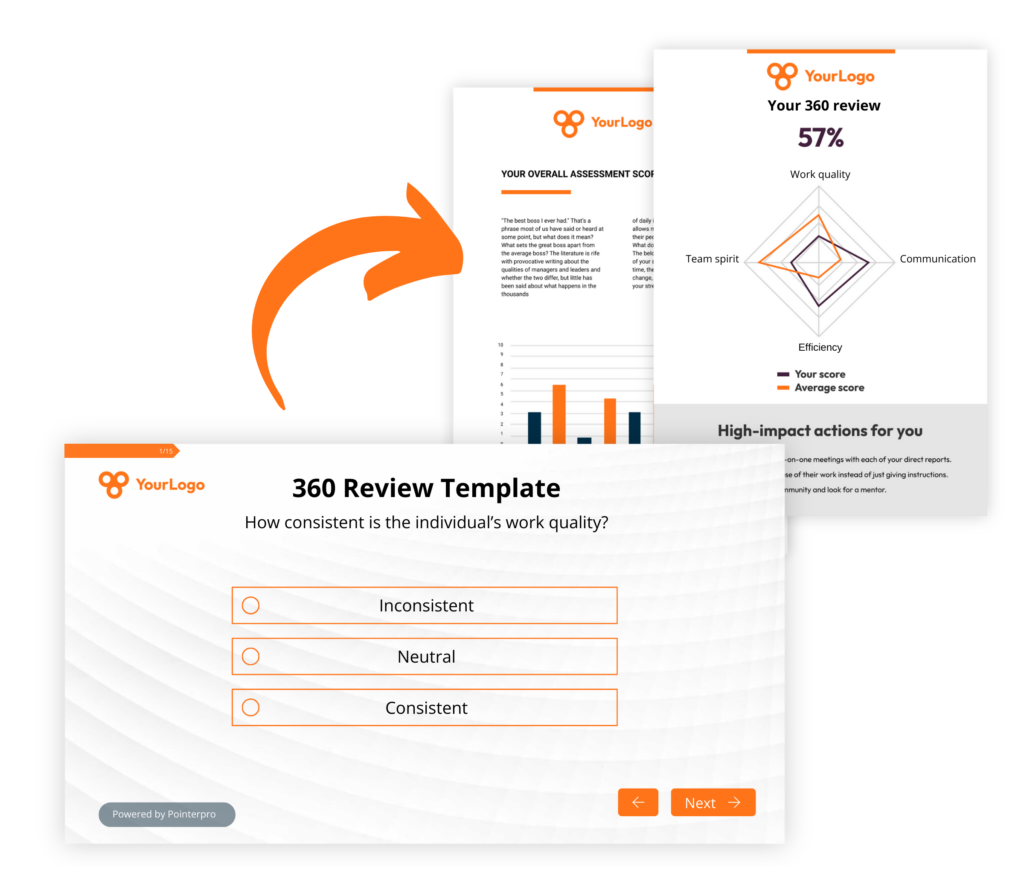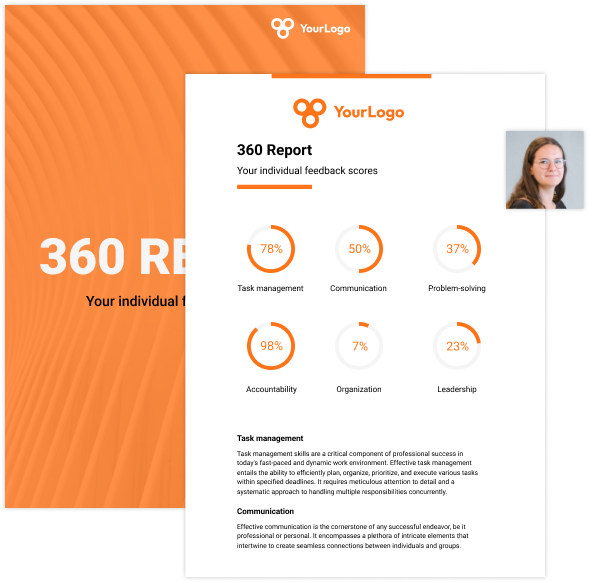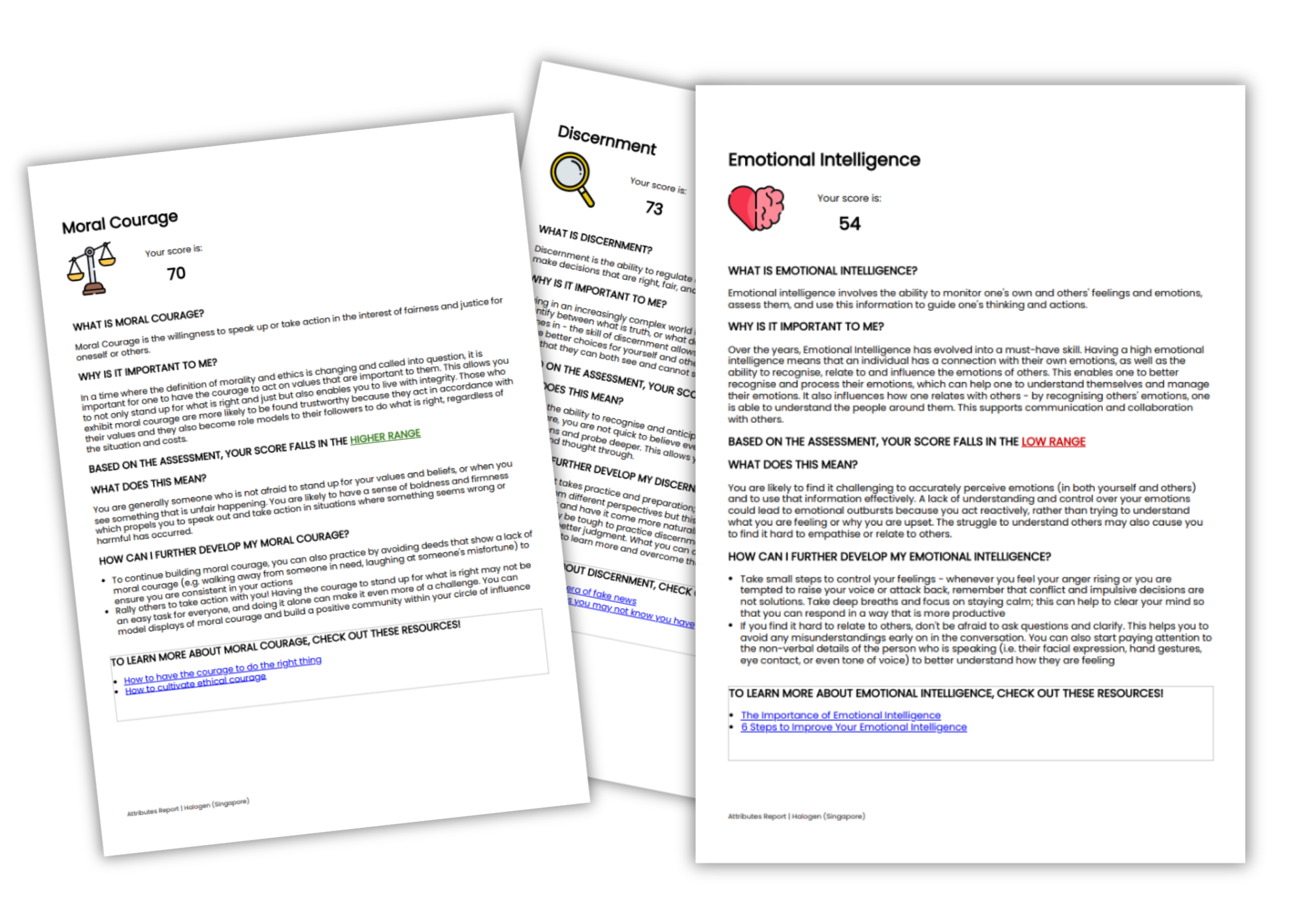360 review template
To get your people and your organization to move forward, you need 360 reviews that result in clear and consistent feedback.
Standardize your 360 review approach by building well-balanced and engaging online assessments.
Pointerpro is the 2-in-1 software that combines assessment building with personalized PDF feedback report generation.

What is a 360 review?
A 360-degree review is a comprehensive feedback process that gathers input from multiple sources, including supervisors, peers, subordinates, and sometimes clients or external stakeholders, to evaluate an individual’s performance. It provides a holistic perspective on an individual’s strengths, weaknesses, and areas for development. In a digitalized assessment format, a well-designed 360 review template is a powerful and scalable facilitator for personal and professional growth in any company.
3 reasons to use Pointerpro as a 360 review tool
Interactive user experience
With the Questionnaire Builder, you get to create an engaging feedback form. How? With numerous design and layout options, useful widgets, and countless question types.
Refined, score-based analysis
Our custom scoring engine helps you quantify and categorize diverse answers. The result? An objective and nuanced 360 review that helps your employees forward.
Automated feedback in PDF
Thanks to your setup in the Report Builder, and its Aggregate Reports feature, employees get a detailed PDF report: with personalized feedback, useful tips, and an action plan.
1.500+ businesses worldwide build assessments with Pointerpro









How do you structure a 360 review?
No HR or talent manager wants to see talented employees stagnate or leave the company. Even worse? Realizing this happens because of inaccurate or inconsistent performance evaluations. To keep that from happening, more and more companies initiate the process of implementing 360-degree reviews or simply “360 reviews” across relevant departments.
Structuring a 360 review process effectively requires several key steps. If you’re thinking about setting it up, you better tick these boxes first:
- Identify reviewers: Select a diverse group of reviewers who can provide comprehensive feedback on the individual's performance. This typically includes peers, direct reports, supervisors, and sometimes clients or other stakeholders who interact with the individual regularly.
- Choose evaluation criteria: Define the specific competencies, skills, and behaviors that will be assessed in the review. These criteria should be relevant to the individual's role and responsibilities, as well as aligned with the organization's goals and values.
- Ensure anonymity and confidentiality: Assure reviewers that their responses will remain anonymous and confidential to encourage honest and constructive feedback. This helps create a safe environment for open communication and reduces the likelihood of biased or filtered responses.
- Get the right assessment tool: Create questionnaires that allow reviewers to provide feedback on the identified criteria. They should be designed to gather both quantitative ratings and qualitative comments, providing a well-rounded view of the individual's performance.
- Consolidate feedback and make it actionable: Think of an effective way to transmit the 360 feedback with key action points to the individual employee, like a review report. To be fully constructive and supportive, follow up with physical dialogue, between a human resources professional or external coach and the employee.
It’s important to make the process repeatable and scalable. By developing a 360 review template with Pointerpro you’ll make your review process more consistent and therefore more effective.
How to write a 360 review for honest feedback
This should be a rhetorical question, but we’d understand if you asked. It’s actually worth zooming in on! Honest feedback in a 360-degree review is crucial because it ensures accuracy, and promotes a company culture of self-awareness, transparency, trust, and credibility.
It provides individuals with a clear understanding of their performance, strengths, and areas for development. That’s the only way to make meaningful progress in their careers. To write a 360 review that encourages honest feedback, follow these guidelines:
- Set clear expectations: Clearly communicate the purpose and expectations of the 360 review process to both reviewers and the individual being reviewed. Emphasize the importance of honest and constructive feedback in supporting professional development and organizational success.
- Assure anonymity (!): We know we already mentioned this, but it's crucial. Reiterate to reviewers that their responses will be kept confidential and anonymous. This helps alleviate concerns about potential repercussions for providing honest feedback.
- Include open-ended and closed questions: You need to both allow reviewers to provide detailed and candid feedback. However, avoid biased questions that may influence responses. However, predominantly use multiple-choice questions too. This will allow you to score assessments and therefore make feedback more objective.
- Encourage specific examples: Prompt reviewers to provide specific examples or instances to support their answer choices. This adds context and credibility to their comments and helps the individual being reviewed understand the areas for improvement more clearly.
- Focus on behavior, not personality: Frame feedback in terms of observable behaviors and actions rather than personal traits or characteristics. This keeps the feedback constructive and objective, avoiding personal attacks or judgments.
- Balance positive and negative feedback: Include both strengths and areas for improvement in the review to provide a balanced perspective. Acknowledging strengths helps maintain morale and motivation while addressing weaknesses facilitates growth and development.
- Follow up appropriately: After the review process, ensure that feedback is appropriately followed up on. Ideally you’re able to translate different outcomes of a 360 review into a plan for improvement. That’s why having a solid 360 review template is so valuable.
- Foresee training and guidance: Offer training or guidance to reviewers on how to give effective feedback. This may include communication techniques, active listening skills, and tips for delivering constructive criticism in a respectful manner.
Out of the box ideas
Unfortunately, no matter what, people tend to be biased. So you have to be creative to navigate that. Here are a few ideas:
- Blind review process: Implement a blind review process where the identity of the individual being reviewed is concealed from the reviewers. This removes biases associated with personal relationships or hierarchical dynamics, encouraging more honest and objective feedback.
- Storytelling exercises: Incorporate storytelling exercises or narrative-based feedback sessions where reviewers are encouraged to share specific examples or anecdotes that illustrate their observations. This approach can make feedback more relatable and memorable, fostering deeper insights and honest reflections.
- Anonymous peer review exchange: For employee peer review specifically, you can set up an anonymous peer feedback exchange program where individuals anonymously exchange feedback with their peers on a rotating basis. This reciprocal arrangement can promote trust and accountability among colleagues, leading to more honest and constructive feedback.
- Gamification: Gamify the feedback process by turning it into a fun and engaging activity. For example, you can create challenges that incentivize participation and reward honest feedback. This approach can help overcome reluctance to provide critical feedback and encourage active engagement in the review process.
What are the key components of a good 360 review template?
At Pointerpro, we continue to preach the triple-A: “Ask. Assess. Advise” To get the wanted results out of your HR assessment efforts, you need to set up a 360 review template that consists of well-thought-of questions (Ask), scored answer options (Assess), and actionable feedback based on the first two (Advise):
The 360 review questionnaire: 5 tips
Here are a few things that many HR and L&D professionals lose sight off when developing 360 review questionnaires. Take them into account to make yours as effective as possible:
- Balanced evaluation: The questionnaire should include a balanced mix of questions covering both specific job-related competencies and behavioral attributes, ensuring a comprehensive assessment.
- Clear and concise language: Questions should be written in clear and concise language to ensure understanding and facilitate accurate responses from reviewers.
- Scalability: The questionnaire should be adaptable to different roles and levels within the organization, allowing for customization to specific job requirements and responsibilities.
- Rating scales: Utilize rating scales that are easy to interpret and provide meaningful insights, such as Likert scales or numerical scales, to quantify feedback effectively.
- Validity and reliability: Test your questionnaire for validity and reliability to ensure that it accurately measures the intended competencies and produces consistent results over time.
The 360 review report: 6 tips
A truly effective 360 review should lead to a formal report, otherwise questions and answers just float around in the air, no matter how valuable. Both for the individual employee that’s being reviewed and for the manager or HR manager following up on him or her, a document like this provides a grip on the situation. Here are a few pointers to do well.
- Show objectivity: Demonstrate objectivity in the report's presentation by accurately reflecting the feedback received without bias or favoritism, enhancing its credibility and relevance to the individual's growth. Using scores, graphs, and charts - an dif possible relevant benchmarks.
- Balanced perspective: Be sure to offer a balanced “feedback sandwich.” Highlight both positive feedback and areas for improvement. This will foster a constructive dialogue afterward and motivate the individual to capitalize on their strengths while addressing weaknesses too.
- Actionable recommendations: Include actionable recommendations or suggestions for improvement based on the feedback provided, guiding the individual towards specific steps they can take to enhance their performance and professional development. You may even present your report as a “maturity assessment” report.
- Support and resources: Offer support and resources to help the individual implement feedback and achieve their development goals, such as coaching, training programs, or mentorship opportunities, demonstrating organizational commitment to their growth and success.
- Comprehensive feedback: The report should provide a comprehensive summary of feedback received from multiple sources, offering insights into strengths, weaknesses, and areas for development across various dimensions
- Clarity and transparency: Ensure that the report is presented in a clear and understandable format. Therefore don’t underestimate the importance of design. Don’t overload report pages with text but keep things concise.
How long should a 360 review report be?
The actual length of a 360 review report can vary depending on factors such as the complexity of the evaluation, the number of participants, and the depth of feedback provided.
However, as a general guideline, a 360 review report typically ranges from 5 to 15 pages. It should be long enough to provide comprehensive feedback and actionable recommendations but concise enough to maintain the reader’s attention and focus on key insights.
20 privacy impact assessment example questions

Here are 20 360 review assessment example questions divided into 2 categories:
- 10 360 performance review example questions
- 10 360 peer review example questions
10 360 performance review example questions
- How effectively does the individual communicate with team members and stakeholders?
- To what extent does the individual demonstrate leadership skills in guiding and motivating their team?
- How well does the individual handle conflict resolution and manage difficult situations?
- How accurately does the individual assess their own strengths and weaknesses?
- How effectively does the individual prioritize tasks and manage their workload?
- To what extent does the individual demonstrate adaptability and resilience in challenging situations?
- How well does the individual collaborate and work effectively with others in a team environment?
- How consistently does the individual deliver work of high quality?
- To what extent does the individual seek and incorporate feedback for continuous improvement?
- How well does the individual demonstrate a commitment to the organization's values and goals?
The approach for creating effective 360 performance review questions involves addressing key competencies and behaviors relevant to the individual’s role. Each 360 review template question listed above is clear and specific. For many of these questions, you could use a rating scale to quantify a score. Additionally, you could provide a range of answer options that allow for nuanced responses, ensuring a comprehensive evaluation of the individual’s performance.
For almost every question you could potentially provide the option for the respondent to add some qualitative feedback too.
10 360 peer review example questions
When crafting peer review questions, it’s important to focus on aspects of the individual’s performance and behavior that are observable by colleagues. These questions should prompt peers to provide feedback based on their interactions and observations, fostering a holistic assessment of the individual’s effectiveness in the workplace. Additionally, the questions should be clear, specific, and relevant to the individual’s role and responsibilities.
Here are some 360 review template questions specifically for peer reviewing:
- How effectively does the individual contribute to team discussions and decision-making processes?
- To what extent does the individual demonstrate empathy and consideration towards colleagues' perspectives and opinions?
- How well does the individual communicate and share information with peers, ensuring clarity and understanding?
- How reliable is the individual in fulfilling commitments and following through on promises made to peers?
- How responsive is the individual to requests for assistance or collaboration from peers?
- How well does the individual support and mentor peers in their professional development and growth?
- How constructive is the individual in providing feedback and suggestions to peers for improvement?
- How inclusive is the individual in fostering a sense of belonging and camaraderie within the team?
- To what extent does the individual demonstrate integrity and trustworthiness in their interactions with peers?
- How effectively does the individual resolve conflicts and manage disagreements with peers in a respectful and professional manner?
What Pointerpro clients are saying




Who to include in 360 reviews?
When selecting reviewers for a 360 review, it’s essential to gather input from various perspectives to ensure a comprehensive assessment of the employee’s performance. Here’s a list of seven potential reviewers along with some creative reasons why each may be useful:
- Direct supervisor: This person supervisor can provide insight into the employee's day-to-day performance, goal attainment, and adherence to organizational expectations. Additionally, they can offer valuable feedback on the employee's alignment with the team's objectives and their effectiveness in executing assigned tasks.
- Peers or colleagues: They can offer unique insights into the employee's teamwork, collaboration skills, and interpersonal relationships. They may observe aspects of the employee's behavior that are not evident to supervisors, such as their influence within the team, communication style, and willingness to support others.
- Subordinates: These people can provide valuable feedback on the employee's leadership and management capabilities. Their perspective can shed light on the employee's effectiveness in providing guidance, support, and direction to their team members, as well as their ability to foster a positive and productive work environment.
- Cross-functional partners: Co-workers or partners from other departments or teams can offer insights into the employee's collaboration skills, adaptability, and ability to work effectively across organizational boundaries. Their feedback can highlight the employee's impact on broader initiatives, interdisciplinary projects, and organizational culture.
- Customers: They are the ones who interact with the employee on a different level. They can provide valuable feedback on their customer service skills, responsiveness, and ability to meet client needs. Their perspective can help assess the employee's performance in delivering value to external stakeholders and maintaining positive relationships with clients.
- Mentors or coaches: A mentor or coach can provide developmental feedback based on their guidance and observations of the employee's growth over time. They can offer insights into the employee's progress, areas for improvement, and potential for future development, drawing from their expertise and experience.
- Self-evaluation: Encouraging the employee to conduct a self-evaluation allows them to reflect on their own performance, strengths, and areas for growth. This introspective process can promote self-awareness, accountability, and ownership of their professional development journey.
It’s important to note that each case is different, and the selection of reviewers should be tailored to the specific context and objectives of the 360 review.
Consider factors such as the employee’s role, responsibilities, relationships, and areas of focus when determining who should participate as reviewers. Additionally, be mindful of the organizational culture, dynamics, and confidentiality considerations when soliciting feedback from different stakeholders.
Create your 360 review today
You may also be interested in
Recommended reading

Vlerick Business School digitalizes entrepreneurship development with Pointerpro [case study]
What do a top-tier international business school based in the capital of Europe and Pointerpro have in common? At the

Attain Global: How to do psychometric tests right and build a cutting-edge international business [case study]
In many countries worldwide, the pursuit of skillful and engaged employees is not so much a war on talent as

How youth development specialist Halogen reaches thousands of young Singaporeans with Pointerpro [case study]
Singapore, in Southeast Asia, is a global, economic powerhouse with a population of a little less than 6 million people.


